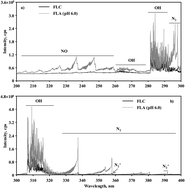Influence of pH and low-molecular weight organic compounds in solution on selected spectroscopic and analytical parameters of flowing liquid anode atmospheric pressure glow discharge (FLA-APGD) for the optical emission spectrometric (OES) determination of Ag, Cd, and Pb
Abstract
Atmospheric pressure glow discharge operated in contact with a flowing liquid anode (FLA-APGD), with the solution pH adjusted to pH 6.0 or pH 1.0, was performed to elucidate plasma-chemical processes and reactions occurring in the discharge and the liquid phase. The morphologies in the emission spectra of both FLA-APGD systems in reference to molecular (NO, OH, N2, and N2+) and atomic (H and O) excited species in addition to selected spectroscopic parameters, including the rotational, vibrational, and excitation temperatures and electron number density, were assessed for both discharge systems and compared with those evaluated for APGD operated in contact with a flowing liquid cathode (FLC-APGD). The effect of low-molecular weight (LMW) alcohols (methanol and ethanol) and carboxylic acids (formic acid and acetic acid) added to the FLA solution on the morphology of the spectra and spectroscopic parameters of both discharge systems was studied as well. The analytical performance of both FLA-APGD systems, compliant with the intensities of the atomic lines of Ag, Cd, and Pb, the signal-to-background ratios of these lines, and the detection limits of Ag, Cd, and Pb, under conditions of the absence and presence of the aforementioned LMW organic compounds was determined and compared. It was established that APGD operated in contact with FLA solutions acidified to pH 1.0 or buffered to pH 6.0 conferred a unique set of advantages as compared to the case of the FLC-APGD system. Both FLA-APGD systems were characterized by a large population of high energy electrons and molecular and atomic excited states not quenched by H2O vapor, as in the case of FLC-APGD. Particularly, for the FLA-APGD (pH 1.0) system, the addition of LMW organic compounds resulted in an improvement in its analytical performance for the detection and determination of Ag, Cd, and Pb.



 Please wait while we load your content...
Please wait while we load your content...